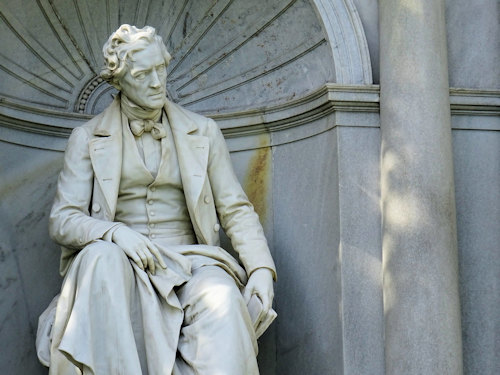One of the more floral parts of Vienna is the rose garden in the Volksgarten park. Wander among the blooms down to one end to find a large semi-circular monument full of dramatic reliefs, with a stone gentleman holding a book in one hand. Say hello to Franz Grillparzer.
- 1889 monument to one of Austria’s literary giants
- Reliefs depict scenes from six Grillparzer plays
- Fully renovated at the end of 2021
- Take a historical walking tour* of Vienna
- See also:
- Beethoven in Vienna
- The Literature Museum (includes his office)
The Grillparzerdenkmal

(Franz seated between scenes from his works)
Franz Grillparzer (1791-1872) counts as one of Austria’s most renowned and prolific poets, playwrights, and writers in general; the Literature Museum has his office on display, and the Wien Museum includes a reconstruction of part of his home.
However, unlike contemporaries such as Beethoven (who once shared a house with him), Grillparzer has not enjoyed long-lasting international success. Nevertheless, his work continues to find a place on contemporary domestic stages.
To give you an idea of his status, consider that the national theater’s first production post-WWII in a liberated Vienna was Grillparzer’s tale of unrequited love in ancient Greece: Sappho.
Coincidentally, Sappho’s parting from the lovers Phaon and Melitta actually features in one of the stone reliefs that flank the monument’s central statue. The others are:
- The final scene from Die Ahnfrau
- The final scene of Act I in Der Traum ein Leben
- The feudal scene in Act III of König Ottokars Glück und Ende
- The final scene of Act III in Medea (the third part of Grillparzer’s Golden Fleece trilogy)
- The first scene of Act III in Des Meeres und der Liebe Wellen

(An 1889 newspaper piece on the unveiling of the monument; Wien Museum Inv.-Nr. 199494; excerpt reproduced with permission under the terms of the CC0 licence)
The unveiling of the monument took place on May 23rd, 1889, in sunny spring weather and to the general approval of the assembled guests, one of whom was Grillparzer’s former physician.
Plans to erect such a memorial had begun shortly after the playwright’s death.
Apparently, the long delay between conception and completion owed in part to deep snow delaying mining of the required marble for the statue. Long debates about which of Grillparzer’s works should feature on the reliefs also played a role.
Somewhat unusually, two sculptors created the monument: a melding of competing bids for the contract put out to tender by a private committee (albeit with substantial financial support from the Kaiser).
The statue is by Carl Kundmann, who also made Schubert’s gravestone in the Zentralfriedhof cemetery. The reliefs are by Rudolf Weyr, whose other contributions in Vienna include the Brahms monument at Karlsplatz.

(A suitable pose for a bibliophile)
Both these sculptors also contributed works to the statues, busts and reliefs that decorate the various prestigious museums and other buildings that went up around the Ring in the late 19th century.
According to a newspaper report of the day, Grillparzer himself had (with tongue in cheek) once suggested any monument to him should have him on a horse, partly because the idea of standing for so long had little appeal.
He added:
Don’t forget the horseshoes, either, otherwise the shoemakers’ apprentices will laugh at the sculptor and I’ll think it’s directed at me
No doubt the playwright would have approved of Kundmann’s decision to portray him in a sitting position.
How to get to Grillparzer
Find your way to the Volksgarten, then just walk up to the opposite end from the Burgtheater (Grillparzer looks out over the rose garden across to the new home of the institution where his plays often premiered).
Address: Volksgarten, 1010 Vienna
